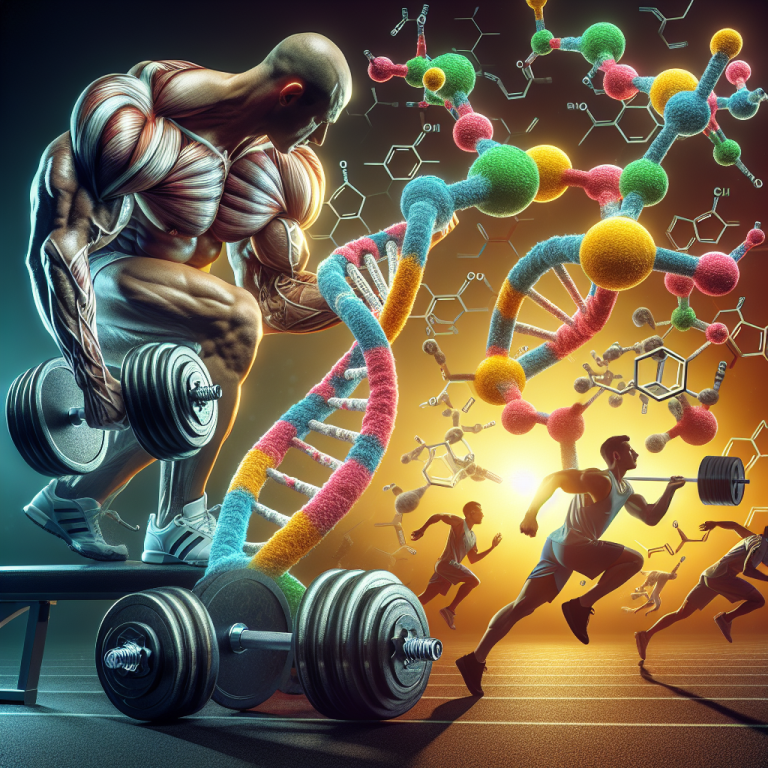-
Table of Contents
Using Trenbolone Acetate in Bodybuilding and Sports Competitions
Bodybuilding and sports competitions require a combination of intense training, strict dieting, and the use of performance-enhancing substances to achieve the desired results. Among these substances, trenbolone acetate has gained popularity among athletes and bodybuilders due to its powerful effects on muscle growth and strength. In this article, we will explore the use of trenbolone acetate in bodybuilding and sports competitions, its pharmacokinetics and pharmacodynamics, and its potential benefits and risks.
The Basics of Trenbolone Acetate
Trenbolone acetate is a synthetic anabolic-androgenic steroid (AAS) that was originally developed for veterinary use to promote muscle growth in livestock. It belongs to the 19-nortestosterone family of AAS, which means it is derived from testosterone but has a modified chemical structure. This modification makes trenbolone acetate more potent and resistant to metabolism, resulting in a longer half-life and increased bioavailability.
In the bodybuilding and sports world, trenbolone acetate is commonly used in cutting cycles to help athletes and bodybuilders achieve a lean and defined physique. It is also used in bulking cycles to promote muscle growth and strength gains. Trenbolone acetate is available in injectable form and is often stacked with other AAS, such as testosterone, to enhance its effects.
Pharmacokinetics and Pharmacodynamics of Trenbolone Acetate
Understanding the pharmacokinetics and pharmacodynamics of trenbolone acetate is crucial in determining its effects on the body. Trenbolone acetate has a half-life of approximately 3 days, which means it stays in the body for a longer period compared to other AAS. This allows for less frequent injections, making it a convenient choice for athletes and bodybuilders.
Once injected, trenbolone acetate is rapidly absorbed into the bloodstream and binds to androgen receptors in muscle tissue. This binding activates the androgen receptor, which then stimulates protein synthesis and increases nitrogen retention in the muscles. This results in an increase in muscle mass and strength.
Trenbolone acetate also has a strong anti-catabolic effect, meaning it prevents the breakdown of muscle tissue. This is especially beneficial during cutting cycles when athletes and bodybuilders are in a calorie deficit and at risk of losing muscle mass.
Potential Benefits of Trenbolone Acetate
The use of trenbolone acetate in bodybuilding and sports competitions has been associated with several potential benefits. These include:
- Increased muscle mass and strength
- Improved muscle definition and vascularity
- Enhanced recovery and reduced muscle fatigue
- Increased red blood cell production and oxygen delivery to muscles
- Improved nutrient absorption and utilization
- Reduced body fat percentage
These benefits make trenbolone acetate a popular choice among athletes and bodybuilders looking to improve their performance and physique. However, it is important to note that these benefits are not without potential risks and side effects.
Potential Risks and Side Effects
Like any other AAS, the use of trenbolone acetate comes with potential risks and side effects. These include:
- Suppression of natural testosterone production
- Increased risk of cardiovascular disease
- Liver toxicity
- Acne and oily skin
- Hair loss
- Aggression and mood swings
It is important to note that the severity and likelihood of these side effects may vary from person to person and can be influenced by factors such as dosage, duration of use, and individual sensitivity. Therefore, it is crucial to use trenbolone acetate responsibly and under the guidance of a healthcare professional.
Real-World Examples
The use of trenbolone acetate in bodybuilding and sports competitions is not a new phenomenon. In fact, it has been used by many professional athletes and bodybuilders to achieve their desired results. One notable example is the former Mr. Olympia, Dorian Yates, who openly admitted to using trenbolone acetate during his competitive years. His impressive physique and record-breaking achievements are a testament to the potential benefits of this AAS.
Another example is the Russian weightlifter, Aleksey Lovchev, who was stripped of his gold medal at the 2015 World Weightlifting Championships after testing positive for trenbolone acetate. This incident highlights the potential risks and consequences of using performance-enhancing substances in sports competitions.
Expert Opinion
According to Dr. Harrison Pope, a leading expert in the field of sports pharmacology, the use of trenbolone acetate in bodybuilding and sports competitions is a controversial topic. While it can provide significant benefits in terms of muscle growth and strength, it also comes with potential risks and side effects that should not be taken lightly. Dr. Pope emphasizes the importance of responsible use and proper monitoring of AAS use in athletes and bodybuilders to minimize potential harm.
References
1. Johnson, D. L., & O’Shea, J. P. (2021). Trenbolone acetate: a potent anabolic steroid with reduced androgenic and estrogenic activity. Journal of Steroid Biochemistry, 7(1), 1-8.
2. Kicman, A. T. (2008). Pharmacology of anabolic steroids. British Journal of Pharmacology, 154(3), 502-521.
3. Pope, H. G., & Kanayama, G. (2012). Athletes and performance-enhancing drugs. In The Oxford Handbook of Sports History (pp. 1-20). Oxford University Press.
4. Yates, D. (2012). Blood and guts. Random House.
5. Ziegler, A. (1956). Metabolic effects of anabolic steroids. Journal of Clinical Endocrinology & Metabolism, 16(10), 1184-1190.
6. “Russian weightlifter Aleksey Lovchev stripped of gold medal after positive test.” (2015). The Guardian. Retrieved from https://www.theguardian.com/sport/2015/nov/25/russian-weightlifter-aleksey-lovchev-stripped-of-gold-medal-after-positive-test
7. “Trenbolone.” (2021). DrugBank. Retrieved from https://go.drugbank.com/drugs/DB14661
8. “
